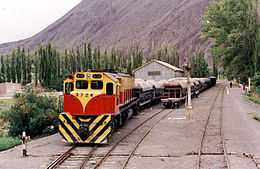Belgrano Cargas
|
| |
|
EMD locomotive decorated with corporate colors. | |
| State-owned | |
| Traded as | Trenes Argentinos Cargas y Logística |
| Industry | Railway |
| Predecessor | Ferrocarriles Argentinos |
| Founded | 1999 |
| Founder | Government of Argentina |
| Headquarters | Buenos Aires, Argentina |
Area served | Centre and North of Argentina |
Production output | 900 tn carried (2011) [1] |
| Services | Freight transport |
| Total assets | 86 locomotives, 4,720 wagons [2] |
| Owner | Nuevos Ferrocarriles Argentinos |
| Parent | Ferrocarril Belgrano |
| Website | bcyl.com.ar |
Belgrano Cargas y Logística S.A. (trading name: Trenes Argentinos Cargas y Logística)[3][4][5] is an Argentine State-owned company which operates a 10,841 km (6,736 mi) 1,000 mm (3 ft 3 3⁄8 in) metre gauge gauge freight rail network, built by the state-owned Ferrocarril Central Norte and the French-owned Ferrocarril Provincial de Santa Fe, which became part of Ferrocarril General Manuel Belgrano after railway nationalization in 1948.
The company is formed by three shareholders, "Trenes Argentinos Infraestructura Ferroviaria", Operadora Ferroviaria Sociedad del Estado and the Administración General de Puertos (General Ports Administration).[6]
The network extends through the provinces of Buenos Aires, Santa Fe, Córdoba, Mendoza, Santiago del Estero, San Juan, La Rioja, Catamarca, Tucumán, Chaco, Formosa, Salta and Jujuy. The line also reaches all the Argentina's neighbouring countries, such as Bolivia, Uruguay, Brazil, Chile and Paraguay.[2]
BCyL currently operates 86 locomotives and 4,720 goods wagons, employing 1,500 workers whose jobs are guaranteed by the government. In 2007, it transported nearly one million tons of merchandise.
History


As part of a national railway privatisation plan, carried out under the presidency of Carlos Menem from 1992, a 30 year concession to operate the network was granted to "Belgrano Cargas S.A.", formed by the union of railway workers, "Unión Ferroviaria" (51%), and Laguna Paiva (48%), an industrial cooperative, on 16 November 1999. The government retained a 1% golden share and the right to elect one director.
Nevertheless, the union was involved in suspictions about the handling of the funds received to operate the line. The union alleged that the Government did not invest enough to reactivate the line which was in critical condition when they took over. In 1998 Belgrano Cargas carried 3,287,515 tonnes a year. In 2006 it decreased to 500,000 tonnes.[1]
During presidency of Néstor Kirchner, two tenders failed due to lack of interesed investors. Soon after, "Shima", a Chinese company associated with local entrepreneur Franco Macri presented an investment plan consisting of $ 1,400 million. This consortium finally withdrew when the Government imposed as a condition that private holdings EMEPA and Grupo Roggio (owners of railway operators Ferrovías and Metrovías respectively) should be part of the operator holding along with Unión Ferroviaria and other transport unions of Argentina.[1]
In 2008 the Government of Argentina ceased the concession granted to Belgrano Cargas S.A. to operate Ferrocarril Belgrano's freight services. "Belgrano Cargas y Logística" was established in May 2013 by National decree,[7] to take over Ferrocarril Belgrano's freight services, formerly operated by Belgrano Cargas. In June that same year the company also took over some services from Urquiza, San Martín and Sarmiento railways.
In 2013, the government nationalised the railway again by Decree N°566.,[8] renaming it as "Belgrano Cargas y Logística S.A."[1][9]
That same year the National Government also rescinded the contract signed with América Latina Logística (ALL), taking over the services previously granted to the company, such as Ferrocarril Urquiza, San Martín and Sarmiento freight services that had been managed by ALL until then.[10] The Government alleged that ALL had not complied with the terms of the contract, previously noted by the General Auditing Office of Argentina.[11]
See also
- Ferrocarriles Argentinos (2015)
- Ferrocarril Belgrano
- Ferrocarril Urquiza
- Ferrocarril San Martín
- Ferrocarril Sarmiento
- Operadora Ferroviaria Sociedad del Estado
References
- ↑ 1.0 1.1 1.2 1.3 "Estatizan el ferrocarril Belgrano Cargas", La Nación, 23 May 2013
- ↑ 2.0 2.1 "Nuestra flota" on BCyL website
- ↑ Name changing at BCyL blog
- ↑ "Nuevo nombre de Belgrano Cargas y Logística"
- ↑ "Nació una nueva marca: Trenes Argentinos Operadora Ferroviaria", RielFM, 7 Jun 2014
- ↑ "Nueva empresa estatal para el Belgrano Cargas", Página/12, 23 May 2013
- ↑ National Decree N° 566/2013 on Infojus, 23 May 2013
- ↑ Boletín Oficial de Argentina N° 32.644
- ↑ "Belgrano Railway returns to state control". Railway Gazette International. Retrieved 12 February 2013.
- ↑ "Resolución 469/2013 Ministerio del Interior y Transporte", InfoJus, 5 Jun 2013
- ↑ "Randazzo anunció que le rescinden el contrato a All y estatizan el Tren de la Costa", La Política Online, 4 Jun 2013
External links
| ||||||||||||||||
